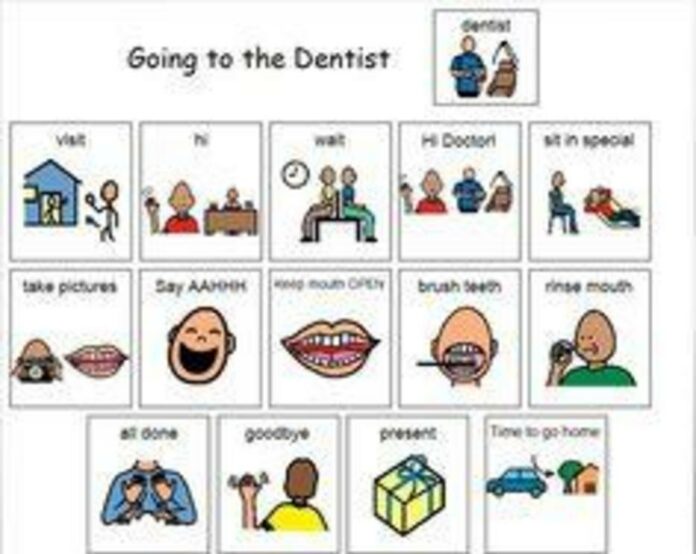Dentistry, cavities, kids, autism
Note: Below is an article from Children’s Health Defense’s The Defender. It’s more than relevant to the autism community. Dental work is often difficult for our kids. And worse so for adults with autism. Did you know that Medicaid only pays for 1 cleaning a year for adults? Many of our adult children require hospital based general anesthesia for a routine cleaning or filling and X-rays. I recently saw a hospital bill for a hospital filling. $16,000. Autism will bankrupt everyone everywhere. Few adult dentists will even treat special needs adults. And most? They just YANK OUT THE TEETH. Take a look at older individuals with ID – gaps, toothless. It’s a travesty. Yet another.
###
Study Sheds New Light on Kids, Tooth Decay and Bacteria ‘Teamwork’
New research by University of Pennsylvania scientists shows how multiple oral bacteria interact in complex ways to form dental plaque, leading to cavities in children. The study found a little-known bacterium that teams up with a known decay-causing microbe to attack tooth enamel aggressively.
By
Angelo DePalma, Ph.D.
More than half of young children and adolescents in the U.S. have at least one dental cavity, with lower-income children more than twice as likely to be affected as kids from well-to-do households.
Gum disease, an even more serious consequence of oral bacteria running amok, has been detected in up to 73% of children under age 11, with incidence climbing during adolescence.
Cavities may be filled, and gum disease successfully treated — but not addressing the underlying causes of these conditions can lead to serious health problems later in life.
In fact, the Mayo Clinic describes oral health as the “window” to overall health, linking poor oral hygiene to several serious conditions related to inflammation, including cardiovascular disease and endocarditis, plus birthing and maternity complications and pneumonia.
Oral bacteria also have been linked to bone loss (osteoporosis), rheumatoid arthritis and dementia.
Now, new research — focused on preschoolers — has uncovered a more complex picture of how bacteria interact in the mouth to cause tooth decay.
Scientists at the University of Pennsylvania discovered that a relatively obscure oral bacterium, Selenomonas sputigena (S. sputigena), collaborates with the well-known decay-causing Streptococcus mutans (S. mutans) to form a “biofilm,” the technical term for plaque, that attacks tooth enamel more aggressively than either bacterium does on its own.
The findings suggest tooth decay may be caused by teams of bacteria working together, rather than a few individual microbe species.
Understanding these complex bacterial interactions could pave the way for more effective strategies to combat cavities, the researchers wrote.
What the researchers found
The study, published earlier this year in Nature Communications and headed by Hyun Koo, D.D.S., Ph.D., analyzed plaque from 416 preschoolers.
Investigators collected biofilm samples and subjected them to several different genetic analyses to identify the bacteria present, their spatial associations and interactions, and which combinations were most strongly associated with tooth decay.
- mutans has been known for some time to be a significant bacterial component of dental plaque, a major contributor to tooth decay.
- mutans are oval-shaped cells that grow in chains or pairs. Cavities form when the mouth’s capacity to neutralize the acid produced by S. mutans is overwhelmed.
Among the most prevalent bacteria in humans, S. sputigena are commonly found in the upper respiratory tract. They usually present no problems to their hosts. However, under the right conditions, they become overgrown and cause blood infection, gum inflammation and tooth decay.
That much was known. What Koo discovered was that S. mutans is most destructive when it joins forces with other bacteria, in particular S. sputigena.
Classic case of the whole being greater than the sum of its parts
Read more at The Defender HERE.
###
Order today, from Skyhorse Publishing.
The Wuhan Cover-Up pulls back the curtain on how the US government’s increase in biosecurity spending after the 2001 terror attacks—facilitated by Dr. Anthony Fauci, director of the National Institute of Allergy and Infectious Diseases (NIAID)—set in motion a plan to transform the NIAID into a de facto Defense Department agency.
While Dr. Fauci zealously funded and pursued gain-of-function research, concern grew among some scientists and government officials about the potential for accidental or deliberate release of weaponized viruses from labs that might trigger worldwide pandemics. A moratorium was placed on this research, but true to form, Dr. Fauci found ways to continue unperturbed—outsourcing some of the most controversial experiments offshore to China and providing federal funding to Wuhan Institute of Virology’s (WIV’s) leading researchers for gain-of-function studies in partnership with the Chinese military and the Chinese Communist Party.
Based on over one hundred studies in the peer-reviewed literature that consider vaccinated versus unvaccinated populations. Each of these studies is analyzed and put in context of the difference in health outcomes of vaccinated versus unvaccinated infants, children, and adults. Given the massive push to vaccinate the entire global population, this book is timely and necessary for individuals to make informed choices for themselves and their families.
Related Stories
- The Dog Days of Summer Are Donation Days for Age of Autism
- PRO-KENNEDY SUPERPAC LAUNCHES ‘THE KENNEDY BEACON’
- Children’s Health Defense Report: Grassroots Backlash Helps Defeat D.C. Schools COVID Vaccine Mandate
For the rest of this article please go to source link below.

